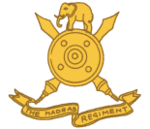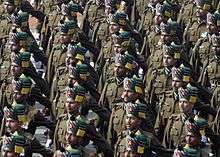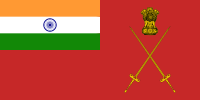Madras Regiment
The Madras Regiment is one of the oldest infantry regiment of the Indian Army, originating in the 1750s. The regiment took part in numerous campaigns with both the British Indian Army and the post-independence Indian Army.
| Madras Regiment | |
|---|---|
 Regimental Insignia of the Madras Regiment | |
| Active | 1758–present |
| Country | |
| Branch | |
| Type | Line infantry |
| Size | 21 battalions |
| Regimental Centre | Wellington, Udhagamandalam (Ooty), Tamil Nadu |
| Motto(s) | Swadharme Nidhanam Shreyaha (It is a glory to die doing one’s duty) |
| War cry | Veera Madrassi, Adi Kollu, Adi Kollu (Brave Madrassi, Strike and Kill, Strike and Kill!) |
| Decorations | 1 Ashoka Chakra 5 Maha Vir Chakra 36 Vir Chakras 304 Sena Medals 1 Nao Sena Medal 15 Param Vishisht Seva Medals 9 Kirti Chakras 27 Shaurya Chakras 1 Uttam Yudh Seva Medal 2 Yudh Seva Medals 23 Ati Vishisht Seva Medals 47 Vishisht Seva Medals 151 Mention-in-Despatches 512 COAS's Commendation Cards 271 GOC-in-C's Commendation Cards 3 Jeevan Rakshak Padak 7 COAS Unit Citations 7 GOC Unit Citation |
| Battle honours | Post Independence Tithwal, Punch, Kalidhar, Maharajke, Siramani and Basantar River. |
| Commanders | |
| Current commander | Lt General Rajeev Chopra[1] |
| Insignia | |
| Regimental Insignia | An Assaye Elephant posed upon a shield with two crossed swords |
History
The town of Madras was founded in 1639 and the first Fort Saint George in 1644. In August 1758 they were formed into regular companies of 100 men each with a due proportion of Indian officers, havildars, naiks, etc. and in December of that year the first two battalions were formed with a European subaltern to each company and a captain to command the whole. (These officers were mostly seconded from the King's service with a step in rank. They were of a better class, better educated and above all had far more military experience than the company's officers).[2]

The Madras Regiment was initially formed as the Madras European Regiment in the 1660s by the East India Company as the second company established in India. However, it was formed as a battalion in 1748 under the command of Major Stringer Lawrence. The battalion was involved in all the battles against the French forces in India.[3][4] Lawrence structured the regiment to include two battalions, one European and one Sepoy (Indian). Both battalions were similar in structure and included seven companies each, with each company including three officers in command and seventy privates. Also part of the companies were four sergeants and corporals and three drummers.[5]
The oldest Battalion in the Madras Regiment (and the Indian Army) was the 9th Battalion, formerly known as the Nair Brigade (Nayar Pattalam, "Nair Army"). This militia was raised in 1704 at Padmanabhapuram as body guards for the Maharajah of Travancore, and were active in the Battle of Colachel in defeating the Dutch forces. The army was made up of soldiers from Nair warrior clans, however after the 1940s, non-Nairs were permitted to join. The "Nayar Army" became incorporated into the Indian Army on April 1951.[6]
In 1748 Major Stringer Lawrence, a veteran of action in Spain, Flanders and the Highlands, was hired by the East India Company to take charge of the defence of Cuddalore. He laid the foundations of what was to become the Indian Army. Training the levies to become a militia, the Madras Levies were formed into "companies" and trained to become a disciplined and fine fighting force. In 1758 Lawrence raised the Madras Regiment, forming the several Companies of Madras Levies into two battalions. 2 Madras was raised in 1776 as the 15th Carnatic Infantry at Thanjavur (and underwent many nomenclature changes thereafter). The regiment has been through many campaigns with both the British Indian Army and the Indian Army. Many well-known British officers have commanded this regiment, among them Robert Clive. This regiment fought in the Carnatic wars, which were fought in South India. The elephant crest symbolises its gallantry in the Battle of Assaye under Arthur Wellesley, later Duke of Wellington.[7]
There after the British annexed the Indian sub-continent, largely with the help of the Madras Regiment sepoys. The coming of the British rule and merging the Presidency armies into a British Indian Army led the erstwhile regiments to be reorganised. After conquest of India, the main perceived threat to British was from Russia. So recruitment was re-oriented towards north Indians of Punjab and Nepal. This resulted in the British reducing the strength of the Madras Regiment since the southern borders were relatively peaceful. After many years, this regiment was re-raised with fresh recruits and a draft of troops from the Madras Sappers during World War II. The newly reborn Madras Regiment performed very creditably during the Burma Campaign.
Post Independence

After independence, the infantry battalions of the Travancore "Nair Pattalam", Cochin and Mysore State forces were amalgamated into the Madras Regiment. Post-independence saw the consolidation of the Regiment and re-affirmation of the versatility and valour of the South Indian troops when the battalions of the Regiment fought fierce battles during the 1947–48 Jammu & Kashmir Operations, the 1962 Sino-Indian Conflict and the Indo-Pak Wars of 1965 and 1971. The deployment of as many as seven battalions of the Regiment in Sri Lanka during Operation Pawan in 1987–89 was a testimony to the faith the Indian Army reposed in the loyalty, dedication and valour of the troops of the Madras Regiment. Two battalions (3 and 25 Madras) of the Regiment have been awarded unit citations by the COAS in recognition of their splendid service in combating insurgency in Jammu & Kashmir and Punjab. Further two battalions served the nation, in the world's highest battlefield in the sub-zero temperatures of Siachen Glacier. The Madras Regiment has taken part in various humanitarian aid operations in India. It has also taken part in various UN Peacekeeping missions.[8]
Current strength

The 1st Battalion (former 73rd Carnatic Infantry) became the 1st Battalion of the Mechanised Infantry Regiment.
Currently the regiment has a strength of 21 battalions as follows:
- 2nd Battalion (old 75th Carnatic Infantry)
- 3rd Battalion (old 79th Carnatic Infantry)
- 4th Battalion (old 83rd Wallajahabad Light Infantry)
- 5th Battalion (Ferocious Five)
- 6th Battalion (old 2nd Btn/2nd Madras Native Infantry)
- 7th Battalion (old 28th Madras Native Infantry)
- 8th Battalion (Gallant Guerrillas)
- 9th Battalion (former 1st Travancore Nair Infantry, Princely State Forces)
- 10th Battalion
- 11th Battalion (old Territorial Battalion)
- 12th Battalion (old Territorial Battalion)
- 16th Battalion (former 2nd Travancore State Nair Infantry, Princely State Forces)
- 17th Battalion (former Cochin State Infantry, Princely State Forces)
- 18th Battalion (former 1st Mysore Wadiyar Infantry, Princely State Forces)
- 19th Battalion (former 2nd Mysore State Infantry, Princely State Forces)
- 20th Battalion (raised 2009)
- 21st Battalion (raised 2011)
- 25th Battalion (old garrison battalion)
- 26th Battalion (old garrison battalion)
- 27th Battalion (old garrison battalion)
- 28th Battalion (old coastal defence battalion)
- 8 Rashtriya Rifles
- 25 Rashtriya Rifles
- 38 Rashtriya Rifles
- 54 Rashtriya Rifles
Besides the 21 line battalions, the Madras Regiment has three Territorial Army battalions:
- 110th Infantry Battalion (TA) situated in Coimbatore, Tamil Nadu
- 122nd Infantry Battalion (TA) situated in Kannur, Kerala
- 172th Infantry Battalion (TA) situated in Campbell Bay, Andaman & Nicobar Islands
Band
The Madras Regiment Band a full time Indian military band that serves as part of the Madras Regimental Centre in Wellington. It was raised in 1951 purely as a brass band and has evolved over the years to become a symphonic band as well. Today, it consists of a concert band, a brass band and a percussion section.[9] It performs at arrival ceremonies for state visits as well as state dinner hosted at the Rashtrapati Bhavan by the President of India, as well as regimental and community events.[10]
Class composition
The regiment still recruits heavily from Tamil Nadu, Kerala, Karnataka and Andhra Pradesh with a slight majority of Tamil- and Malayalam-speaking recruits. Drill commands by NCOs are commonly given in Tamil or Malayalam. However, since the 1990s the percentage from Kannadiga and Telugu speaking recruits has increased, commands are also given through Telugu and Kannada. Also the officers of the regiment can be from any part of India.
Regimental tribute
Let those who come after, see to it that these names be not forgotten,
For they who at the call of duty, left all that was dear to them,
Endured hardships, faced dangers, and finally passed out of sight of men,
In the path of duty and self-sacrifice, Giving their lives that we might live in freedom.
References
- https://www.covaipost.com/coimbatore/new-colonel-of-madras-regiment-to-assume-charge-on-june-1/
- FROM -THE MADRAS REGIMENT 1758–1958 -Lt Col E.G. Phythian-Adams- above added by webmaster www.MadrasRegiment.Org pp. 1–2
- C.K. Cooke, ed. (1901). Empire Review. 2. Macmillan and co. limited. p. 621. OCLC 50083309.
- Harrington, Peter (1994). Plassey 1757 : Clive of India's finest hour. Osprey. p. 40. ISBN 978-1-85532-352-0. OCLC 31969501.
- Addington, Larry H. (1990). The patterns of war through the eighteenth century. Indiana University Press. p. 132. ISBN 978-0-253-20551-3. OCLC 19672195.
- Sharma, Gautam. Valour and Sacrifice: Famous Regiments of the Indian Army. Retrieved 2014-02-15.
- Valour and Sacrifice: Famous Regiments of the Indian Army – Gautam Sharma – Google Books. Books.google.co.in. Retrieved 2014-02-15.
- "Madras Regiment.Org". Madras Regiment.Org. 1970-05-23. Retrieved 2014-02-15.
- https://www.deshgujarat.com/2018/02/16/madras-regiment-symphony-band-of-indian-army-to-perform-at-iima/
- https://www.thehindu.com/features/kids/heroes-from-the-hills/article3906763.ece/amp/
